31 Days, 31 Lists: 2023 Books for Kids with a Message

One of my longer lists. I always feel I need to explain right off the bat what, precisely, I mean by “message”. As has been stated many times before, children’s books were conceived initially as ways of instructing the young. And while what we value most has changed over the years, picture books are often used as helpful conveyance systems of whatever it is we deem important. Now most picture books with a message are, and I mean this sincerely, complete crap. I’m not kidding. In the course of a single year I read hundreds and hundreds and hundreds of these books and if they aren’t dull and preachy then they’re didactic and poorly conceived. There is a reason that most celebrity picture books are “message” books.
But wait. There’s hope.
Today I would like to direct your attention to those books that have something to say, and actually know how to say it. There is nothing wrong with a picture book with a message, as long as that message is beautifully written and illustrated. Today, we’ve a slew of such books. May they give you hope for the future.
ADVERTISEMENT
ADVERTISEMENT
For the full PDF of this list you can find it here.
And if you’d like to see previous years’ message books, look no further than here:
2023 Message Books for Kids
The Artist by Ed Vere
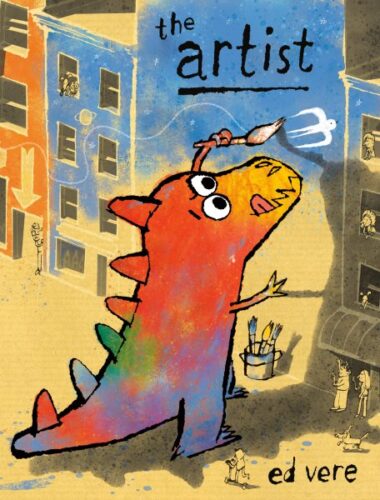
What if Godzilla had an artistic streak rather than a destructive one? Defining the true nature of art to kids is a bit of a daunting prospect. It’s right up there with trying to explain to them how poetry is supposed to make you feel. Fortunately, an artist himself, Vere has the home field advantage. He couches this premise in the story of a little monster (or is she a dinosaur?) determined to bring beauty to the world. If you were to remove the text from the imagery, there would be nothing to distinguish it from the story of a human artist. “The Artist’s head is full. Full of colors, full of feelings. Full of moods, full of dreams. Things imagined and things she has seen. All fizzing, buzzing, bumping together, around and around.” Meanwhile the art itself shows her going off into the wider world (in this case, a large metropolitan city) to try and make it as an artist. I’m disinclined to ever label a book as a graduation book (i.e. a book you hand to a new graduate) but if you know a college Senior going off to art school, this wouldn’t actually be the worst choice of gift in the world, y’know? Ed Vere’s just so good at facial expressions on non-human critters, and this little (huge) artist is no exception. Just a lovely book about making mistakes and carrying on anyway.
Because I Already Loved You by Andrée-Anne Cyr, ill. Bérengère Delaporte, translated by Karen Li
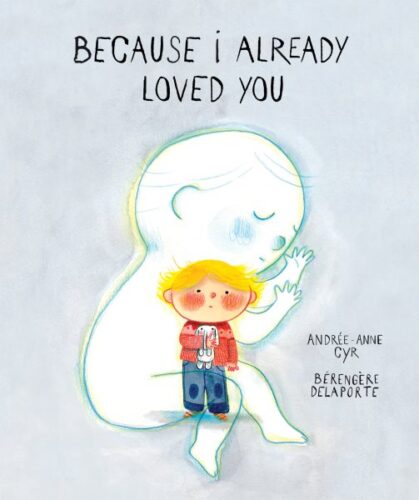
There is no one right way to write a book about a baby sibling dying at birth. And considering how sad and common this is, this is the first book of its kind that I can recall seeing. Topics of this sort too often are published by people with the requisite “M.D.” or “PhD” after their names on the cover. I don’t know that I particularly like such books, most of the time. Now Ms. Cyr is an early childhood educator from Quebec with a background in special education. Somehow she perfectly captures some of the feelings a child may have when all that build up to a new baby sibling is met with the heartbreaking news that there will be no new baby at all. This book is unafraid to dip into the deep well of sadness that the whole family feels after such an event. It also offers the light of hope, and I truly feel that that hope is earned by the text. The gentle assurance that this is no one’s fault is key. In her Author’s Note, Cyr notes that “I have worked with children for many years, and for me, it is essential to be honest and explain the truth to them in accessible words. I wanted to make sure that young readers understand that it’s normal to be sad, while also leaving them with a feeling of hope and love at the end of the story.” I can think of no better book on this subject than this.
Becoming Charley by Kelly DiPucchio, ill. Loveis Wise

“Think Black. Think Orange.” While the other caterpillars do as they’re told, Charley thinks and acts in other ways. Is that safe? A clever tale of choosing your own path to become something, or someone, entirely new. Oo! Who ever thought it was possible to get 1984 vibes off a cute caterpillar picture book? Authoritarianism gets an insect upgrade in this title. Butterflies are such perfect subjects to convey messages that they have almost, over the years, become TOO perfect a subject to convey messages. So maybe it was my knee-jerk reaction to this at the start that made me think I wouldn’t like it that lowered the bar, but I really and truly enjoyed this title! I think Loveis Wise is doing some stand up and cheer work (I like the final spread, particularly since it feels like it’s directly referencing The Very Hungry Caterpillar). And I think DiPucchio really reined in what could have been a thoroughly preachy book (and this isn’t her only book on today’s list, as you will see). THIS is how you write a picture book with a message, people.
Big by Vashti Harrison
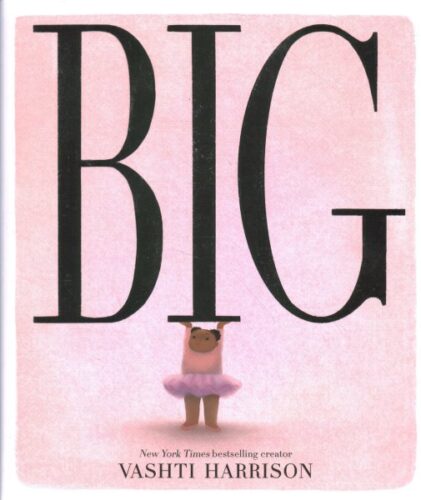
A little girl has a big laugh, a big heart, and big dreams. But when other people start tearing into her because she herself is big, she has to find the bravery to stand out. I can be a hard sell on books that I feel convey more of an overt “message” than anything else. Obviously a large percentage of such books aren’t really much good outside of the message itself. Harrison, however, just exudes talent. As far as I’m concerned the success of Lupita Nyong’o’s Sulwe was due in large part to Harrison’s art. Now she’s tackling fatphobia and particularly where it intersects with racism (though she’s less overt with the latter than the former). When she started working in some Alice in Wonderland references as well, I was truly and thoroughly hooked. And I’m not alone, since it was a National Book Award nominee as well. This book works and it works on beyond its own message. May it teach adults just as often as it does kids.
The Brothers Zzli by Alex Cousseau, ill. Anne-Lise Boutin, translated by Vineet Lal
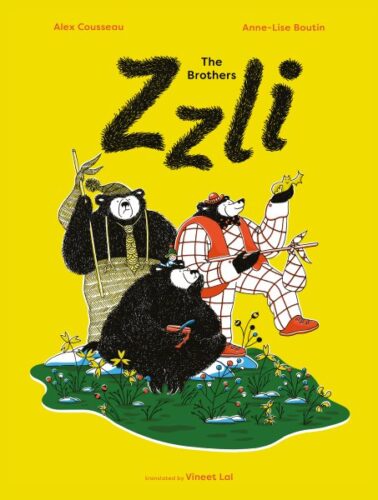
Let’s say that you are a writer of picture books and you are handed an assignment to write one about inclusion, immigration, and acceptance. Make it good. Make it furry. Just fill the darn thing up with bears. Now go. Of the requirements I just listed the most difficult one, without a doubt, is the “Make it good” part. Lord knows we’ve seen plenty of books on immigration or “accepting others” but boy can they get preachy real fast. To do the job properly you need to be a little weird. And Alex Cousseau is unafraid to bring the weird. The whole concept of this book is bizarre, but as extended metaphors go, I’m really quite fond of it. It’s told entirely in the first person (which is kind of rare right there) by a little girl who lives in a simply marvelous little green house deep in the forest. One day three bears arrive introducing themselves as “the four brothers Zzli”. Why four? “Maybe because we eat enough for four.” In spite of their prodigious appetites she finds them “truly delightful.” Driven out of their home they’ve gone through a lot of hardship in their travels and just want to settle down somewhere safe. She invites them to stay with her and all is well for a time. Unfortunately it soon becomes clear that the other animals in the forest do not trust these bears a jot and when that fear turns into pretty much firebombing the girl’s cottage, the bears decide to leave. She goes with them (I mean who would want to live in that community?) with the hope that someday they’ll find a spot where they can all belong. There’s a wordless four-page spread at the end that suggests that they succeed. One can hope, that’s for sure. Done entirely in primary colors, it’s just the loveliest story, but doesn’t skimp on showing how fear makes people do terrible terrible things. Man. You gotta read this one.
The Concrete Garden by Bob Graham
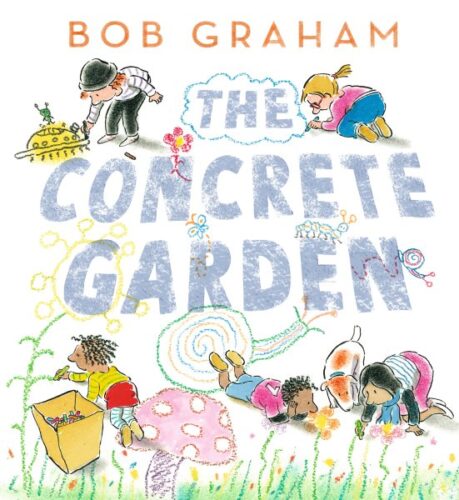
Doggone it. How does Bob Graham do it? The idea that he was working on this book during the early days of COVID while all the rest of us were vegging out watching Tiger King is almost unbearable. Yet the fact of the matter is that when it comes to early pandemic picture book tales, this may be the best we’ve seen so far. Why? Subtlety, my friend. In this story Amanda and her mother live in this massive apartment block. It’s early spring (Spring 2022, I’d wager) and the kids pour out of the building like “candies from a box”. Amanda has been lugging a large cardboard box full of chalk, and she proceeds to create what appears to be a very large image of a COVID-19 virus. Without missing a beat, one of her friends turns it into a dandelion and suddenly all the kids are getting involved (with surprisingly little strife in the process). The image of their “concrete garden” goes viral, but that affects them not at all. And when everything washes away a few days later, are they sad? No! They’re making little cardboard boats and racing them in the water. There are probably ten different messages that you could choose to take from this book. However you want to look at it, it’s certainly about kids being kids and that’s what may save us all.
Connor Kissed Me by Zehava, ill. Sarah K. Turner

Yeah, some people are having a real hard time learning what bodily autonomy is, so every picture book like this one is doing the work of twenty at this point. Being that we live in 2023, you would think we wouldn’t have to constantly explain to adults the fact that kids should not be forcing kisses on other kids. Unfortunately, adults have a tendency to find such behavior “cute”. Zehava, a debut Canadian, gives us the mildest of these situations and shows that it still ain’t great. Miriam’s on the playground having a good time when Connor just gives her a smack on the lips. This is never seen as cool or sweet and Miriam immediately tells her friends and then a series of adults. The recess monitor can’t be bothered, the teacher offers a band-aid to the situation (suggesting to move Miriam’s seat), the bus driver thinks it’s cute, but it’s her mom who’s the only one who asks, “Did you want him to, Miriam?” When she says she didn’t, her mom says she needs to tell Connor directly. The book then doubles back through all those adults again, and this time she informs each one that she didn’t want him to kiss her and they finally come through for her and back her up. Inspired, she tells Connor and he’s taken aback. And the best part? When she tells him he has to ask next time, he does, and she says NOPE with great relish. The book then does not end with the two friends again and playing, but rather with this keen shot of Miriam proudly striding away from him while he stands there, stunned. It’s. Awesome. A lot of times a book of this sort is all going to come down to that last image. Here, you finally get the sense that Connor understands that he did something wrong and it’s not letting him off the hook feeling that way. Maybe, just maybe, he’ll learn. A book that’s gonna do a lot of good in the world (possibly beyond its intended audience).
Empty and Me by Azam Mahdavi, ill. Maryam Tahmasebi, translated by Parisa Saranj

We get a fair number of books about grief in a given year. Of those books, almost none come from other countries and cultures. So to receive an Iranian grief book is interesting in and of itself. That is not, however, any guarantee of quality, so it was very nice indeed to discover that together Mahdavi and Tahmasebi have constructed a uniquely thoughtful take on loss. In this story a young girl has lost her mother. As she says, “Then, Mom died, and Empty took her place.” This being a translation, I’d love to hear what other terms could have been used for that word “Empty” here. It’s a very specific choice to use that and not “Sadness” or “Grief” or anything quite like that. In the book, Empty is depicted as a large white blob, two dots for eyes, looking a little like Baymax from Big Hero 6. And Empty isn’t seen as a vicious or mean-spirited companion. We see her holding its hand on the train and going everywhere with it. Then, slowly, the girl’s father begins to insert himself into the story more and more. The book is not particularly interested in investigating his own grief. Honestly, the book isn’t really focused on him at all, he just appears a little more and more as the story continues. Most interestingly, Empty doesn’t leave at the end, or even really change that much except to contain some flowers that the girl put inside of it. It’s such a gentle, caring title. One that refuses to explain too much, leaving a lot of the interpretation up to the reader. One to remember.
Every Body: A Celebration of Diverse Abilities by Shelley Rotner
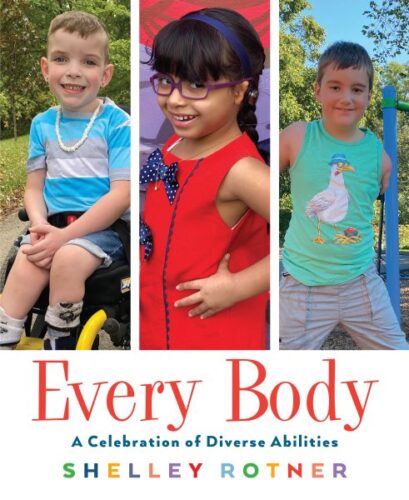
If you’re an aficionado of photography in children’s literature, it can be a lonely lot. There are really only a handful of established photographers to pick and choose between. Fortunately, Ms. Rotner is one of the few. She staked her claim in the world of nonfiction as our preeminent photographer/author years ago, and it’s paid off. Her subjects tend to be actual kids, more often than not, and this book is precisely what it sounds like. Jennifer Browne, the book designer, should probably get equal billing in terms of how the images here are laid out. You’ve full page spreads, pages where there might be eight portraits all at once, and places in between the two. Because a book like this doesn’t systematically explain that one child might have Down’s syndrome or another is deaf, parents and teachers will need to be there to explain elements of the book to kids. It doesn’t pander nor does it make it seem like everything is equally easy for everyone. But with its representation, bright colors, and clear text, it’s a nice one. A posthumous note from Judith Heumann herself (who died earlier this year) as well as other disability rights advocates complements the printed rights recognized by The United Nation’s Convention on the Rights of Persons with Disabilities, and Glossary.
The Fastest Tortoise in Town by Howard Calvert, ill. Karen Obuhanych

A tale of believing in yourself, which is one of the most difficult type of books to write. The hero of this story is “Barbara Hendricks” the pet tortoise. The fact that she happens to have both a first and a last name is so doggone delightful, and yet never really commented on. Barbara’s owner, the well-meaning Lorraine, has entered her pet into a “fun run” against other animals. Barbara worries, reasonably, that she’ll be embarrassed when she loses, but over time she decides to try anyway, with a surprise twist when she does. The book’s art resembles that of Carrie Finison’s Hurry Little Tortoise, Time for School (which I enjoyed thoroughly last year). In any case, I’d rather you didn’t miss this book. I think it got insufficient attention when it was released earlier this year. It would be lovely if some additional eyeballs were to see it. I mean look at that tortoise on the cover. You gonna say no to that face?
Grandpa is Here! by Tanya Rosie, ill. Chuck Groenink
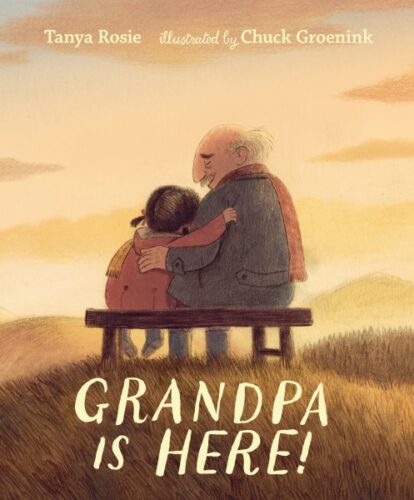
A word in support of grandparent books. No doubt you saw the article out earlier this year decrying the proliferation of “grandma books” on the market today. But lest we get ahead of ourselves, allow me to remind you that not all grandparent books are created equal. Some are, as the article writer correctly identifies, written for the sole purpose of wiggling dollars out of well-meaning grandparent wallets. But others are more in the camp of this book, Grandpa Is Here! In this story a granddaughter is absolutely freakin’ thrilled that her grandfather is coming to visit with “a suitcase [that] smells like spice.” She doesn’t share a language with him but it really doesn’t matter. Of course the true lure of the book is Chuck Groenink’s incredible art. That first shot of her hugging Grandpa at the airport where she has SUCH a kid expression on her face of shyness and affection all at once . . . boy, that is hard to capture. I put this in the “Message” category insofar as the “message” in question is to appreciate your grandparents. But that last shot of her slipping out of her room to touch grandpa’s hand as he sleeps? Incredible. Just a lovely little book.
Grief Is an Elephant by Tamara Ellis Smith and Nancy Whitesides
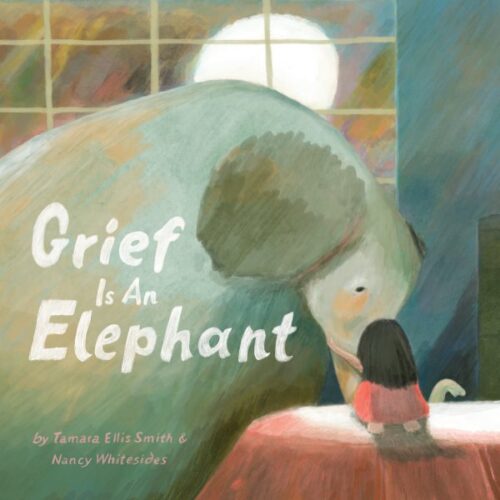
A rather good book to pair with the aforementioned Empty and Me, actually. And I kind of respect a book that says right in the title what it’s about. Grief books can be tricky things to write too. As a librarian, I can tell you that sometimes parents would come up asking for a book that 100% completely replicated their child’s experience (“No no, his grandfather died of heart cancer, not lung cancer”). Other times, they’d be a bit more flexible. They just wanted a story that could mirror their child’s internal experience in some way. An elephant isn’t a bad way to do that. It’s more understandable than a whale, after all. Here, author Tamara Ellis Smith replicates the metaphor of grief with a very heavy elephant. In the course of the story, grief takes a variety of different forms (I liked the fennec fox quite a lot). Meanwhile, Nancy Whitesides is pulling out all the stops with her art. I couldn’t tell if it was computer or pastels or some other medium. Whatever it might be, its the tone of the book that has to be key here, and the Smith/Whitesides combo gets the tone completely right. A fine addition to the grieving picture book set.
Hello, Mister Blue by Daria Peoples
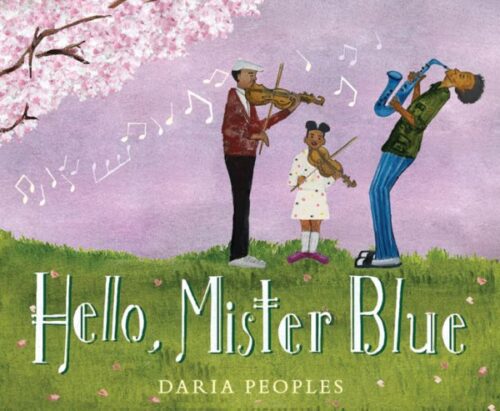
Picture books about the unhoused can really veer off in a number of different directions. At their worst, they’re patronizing. One can be simple without being simplistic, and I think the work Daria Peoples has poured into Hello, Mister Blue reflects that to some extent. The complicated idea of unhoused veterans and the people who used to know them well is explored with an extremely deft hand here. In this story, a young girl introduces us to Mister Blue. He’s been playing music on the streets for years. Her papa knew Mister Blue back in days of war, and at the urging of his daughter gives the man a dry space to play his tunes. There’s something so perfect about little lines like “Is he cold?” “Is he wet?” “Is he hungry?” You don’t need to clutter it up with anything else. It is enough.
I Wish I Could Tell You by Jean-François Sénéchal, ill. Chiaki Okada, translated by Nick Frost and Catherine Ostiguy
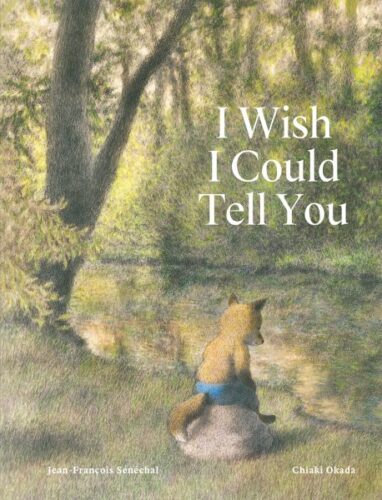
Meet artist Chiaki Okada. A Japanese illustrator, her weapon of choice is the grease-pencil, which gives her art this somewhat ethereal effect with light. According to publisher Milky Way Picture Books, this title is only her second English-language release, though she’s been published in Asia and Europe for years. For my part, I only really heard of this book when Travis Jonker at 100 Scope Notes did his annual round-up of titles he thought might have a chance at the New York Times Best Illustrated List (it’s one of my favorite lists that Travis does). In this story a little fox is writing a letter to his grandmother. She died not long ago, and the fox is wrestling with the fact that the last time he saw her, “I said nothing. Not a word”. You get these delightful flashbacks of the two making squirrels out of acorns and walnut shells and playing in other ways and as well. This is, at its heart, a grief book (we’re getting a lot of these today), but the kind where you just want to sit in the scenes for a while. Okada has a Vermeer-like appreciation for the way that sunlight in midday can stream through a window and hit the tops of a basket full of apples, or the way it can dapple a path in a forest. A book that is more than its subject matter. Previous Seen On: The Caldenott List
Mouse & Giraffe by Kelly DiPucchio, ill. Jen Corace
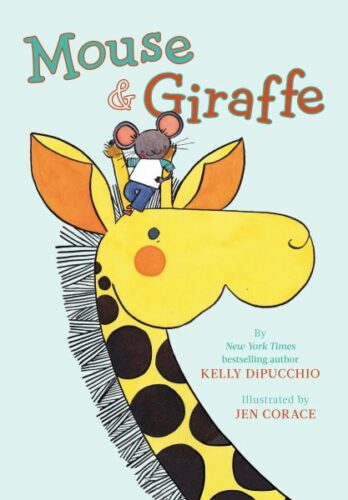
I think that between the two of them DiPucchio and Corace took up more room in my children’s gray matter than a lot of other author/illustrators out there. Have they ever done a book together before? My memory doesn’t conjure anything up. Pity, because they’re a rather natural combination. Now the whole gist of this story is that Giraffe sees things, literally, from one perspective and Mouse from another. They have a devil of a time figuring that fact out, though. For example, Giraffe might say it’s incredibly hot one day while Mouse, sitting in Giraffe’s shade, is as comfortable as can be and can’t figure out what he’s complaining about. Through a series of misadventures they finally are able to see from one another’s point of view. It’s sweet. It’s clever. And it’s a rousing combination that I hope we see more of in the future.
Obioma Plays Football by Chika Unigwe, ill. Chinyere Okoroafor

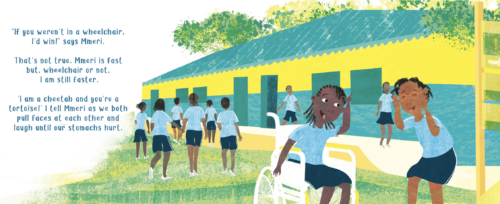
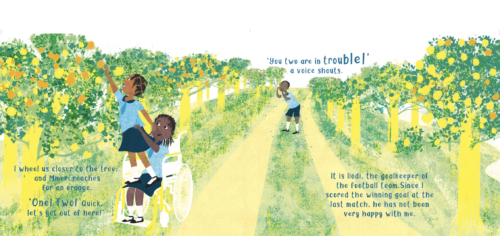
I feel a little bad putting this particular book on this particular list, because I actually think it’s a wonderful example of a book simply being good on its own merits, and devil take the whole “message” idea. Author Chika Unigwe doesn’t ignore the fact that Obioma is in a wheelchair, and indeed the plot centers on her move from a school that’s accessible to one that is not, but as a kid she’s not solely defined by her disability. Obioma is the kind of person who is completely going to race you, and she’s friggin’ going to win too when she does. At her old school she has a stick that she uses to play football, good friends, and she’s a bit of a troublemaker, finding ways to nab oranges from a nearby farm when she’s not supposed to. At her new school there are no ramps so her dad has to carry her into the classroom on the first day, which completely sucks since Obioma loves her independence. Then, when she tries to play football (y’know, soccer) with the other kids, she’s not just facing their ableism but also the fact that she’s a girl. The solution? Starting her own separate girls team and getting what she wants in an entirely different way. Not all her problems are solved at the end of the book, but you can see how she problem solves when she hits barriers. The book is set, I do believe, in Nigeria and is just about one of the finest you’ll find this year. Be sure you don’t miss it!
Rabbit, Duck, and Big Bear by Nadine Brun-Cosme, ill. Olivier Tallec

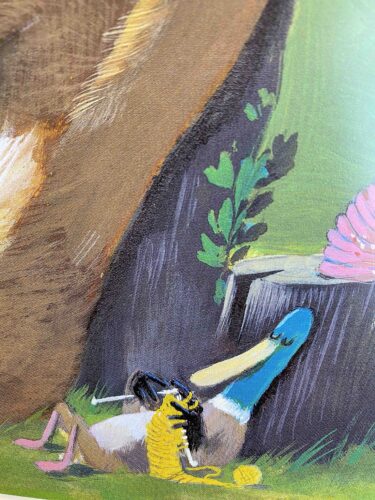
Huzzah! A new Olivier Tallec book is always a cause for celebration. Here we meet our titular characters, all of whom are the best of friends. Tallec gets to wield his wild, expressive style (he’s kind of France’s answer to Frank Morrison) amid beautiful forest backgrounds. I give the book extra points too because the story is not one I’d ever seen before. Three friends live in a woods and like to go everywhere together except down a long, winding path. All is well until one day the rabbit accidentally slips and slides down the path in the cold and snowy winter. Once down she discovers this enormous fir tree. Then comes the revelation that not only do the bear and the duck already know about it, but they spend a lot of alone time with the tree themselves. Now the book could go in any number of directions after this revelation. Instead, the rabbit, and the reader, come to understand that this is okay. Now the rabbit has the tree too and all three, in their own time, can spend some minutes alone with something this vast and grand. A cool message. A cool book.
Soon, Your Hands by Jonathan Sturzman, ill. Elizabeth Lilly

“Tonight, your hand fits inside my own. But soon your hand will grow…” Three families with small children advise and guide until their children become adults themselves. A touching, lovely paean to kids becoming their true selves. Maybe I’m just getting to be an old softie in my old age, but after sitting on this book for a little while it really stuck with me. A lot of that has to do with Elizabeth Lilly’s art, which is just so freakin’ charming. But this really comes across as one of the best examples of how you can do books centering different voices and experiences and make a truly fantastic story out of those people. And yes, that ending kind of hit me in the tear ducts. Like I said. I’m an old softie now. Certainly deserves more reads.
Stickler Loves the World by Lan Smith
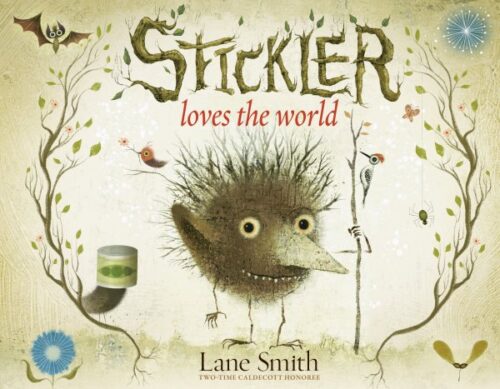
What’s better than loving the world? Getting to show it to someone else for the first time! A thorny little hero gets to show an “alien” why our planet is so darned great. Lane Smith is never boring, but recently he’s avoided the rampant wackiness of his earlier books in favor of heartfelt, meaningful, Henkes-esque stories. Nothing wrong with that. A man’s allowed to mellow with age. Still, it does sometimes leave one yearning for his early days and penchant for wildness. Maybe that’s why I love his latest so very very much. It’s this utterly marvelous combination of the visual wildness of his youth and his more contemporary yearning to celebrate the natural world and all its glory. Stickler looks a little scary, standing there with his stick-like hair and sharp, pointy teeth, but he genuinely loves life and living and our world. He’s got Gappers of Frip energy and a heart of gold. And because Lane combines these visuals with this text, what could have come off as cutesy is instead honestly and legitimately meaningful. You just want to kiss a stick after reading this. My favorite Lane Smith book in years and years.
Stillwater and Koo Save the World by Jon J. Muth
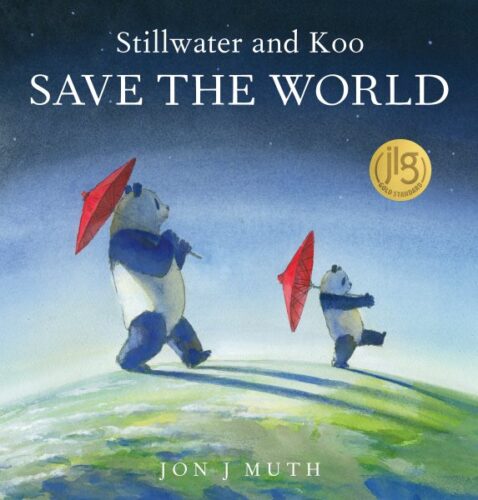
I like Muth and I like Stillwater, but I do wish we could see more of Muth’s stranger offerings like Stanislaw Lem’s Seventh Voyage, and stuff like that. I imagine the Stillwater books probably sell better and are easier to make, so I understand why he keeps churning them out, but a gal can dream. I actually liked this latest offering a little more than some of the other recent Stillwater books, and maybe because it has implications that a lot of kids might be able to relate to. In an era of Greta Thurnberg, kids have a lot more young heroes to look up to in terms of saving the world. But how much can a single, solitary individual accomplish? Muth takes this very real conundrum and turns it into a tale of Stillwater and his nephew doing small good things in the midst of great, gigantic plans. In his Author’s Note, Muth writes that “Children want very much to make the world better, and they look to adults for guidance… Raising our children to value spontaneous kindness gives them enormous and immediate power, because the smallest acts of kindness may save the world.” Acts like this book? You bet.
This Is My Body, I Get to Choose by Brook Sitgraves Turner, ill. Kati Douglas

Little Feminist Press returns! You remember them, right? No? You don’t recall the year a board book won a Stonewall Award? Because that was them, folks, and they pretty much upped the ante on what “diversity” (however you choose to define it) actually means in a board book. I mean, have you ever seen different kinds of feeding tubes featured before? Nope. This book also has a range of folks, but the focus is firmly on, as it says, “An Introduction to Consent”. It’s never too early, after all. It’s covering very basic stuff like “My grownups might help me choose what is safe,” but also good info like “When someone says ‘Stop!’ I stop right away.” It’s an interestingly formatted book, with sturdy pages that will hold up to tugging and a smaller format. Probably ideal for a preschool setting, I’d say. Why don’t you give it a try?
What Happened to You? by James Catchpole, ill. Karen George

Way over in England there’s a literary agency called The Catchpole Agency, which happens to represent everyone from Polly Dunbar to Susannah Lloyd, and it’s run by James and Lucy Catchpole. James, as it happens, has one leg and he wrote this book with good humor and great information. At the end of the book, for example, is a section entitled “Dear Adult” which says, “Does your child want to know everything about every disabled person they see, all at once, and at TOP VOLUME? Here are my suggestions…” Meanwhile, in the story itself, a kid named Joe is playing his favorite pirate game. The problem? “Sharks were easy compared to kids Joe hadn’t met yet.” Slowly a bunch of kids come to Joe wondering how he “lost” his leg, speculating with their own theories. Fortunately, this grows old and Joe’s able to get them involved in a very good piratical game instead. Now I do find the ending where one of the kids says she doesn’t still need to know what happened to Joe’s leg to be a bit on the optimistic side, but Catchpole, with the aid of Karen George’s highly charming art, pulls it off.
When the Stars Came Home by Brittany Luby, ill. Natasha Donovan
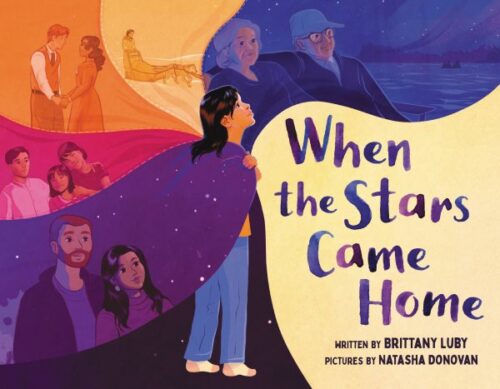
“Home is where you learn who came before you. Home is where you discover who you are. Home is where you imagine who you might become.” I’m cheating and writing the last lines of the book right here up front, but it’s a darn good message and I think it deserves a bit of attention. Brittany Luby (Anishinaabe descent) pairs with Natasha Donovan (Métis) for a story about a kid who moves from the country where his grandparents live, to the city. It’s not entirely clear from the text whether Ojiig was living on a reservation before, but he certainly doesn’t feel at home in this bustling metropolis. I was intrigued by the ways in which Donovan splits up the images on the pages here. The first double spread of Ojiig moving shows lightning bolts separating out the two pages, revealing four different scenes (five, if you count the way in which Ojiig is walking between them). His longing for connection and for the stars at night inspires his mother to tell him the different stories of his ancestors, and these too are featured on the pages overlapping one another. It’s such an eclectic way of telling a story that otherwise could have been rendered dull and static with a more rote form of illustration. A great message but also a great presentation.
Why Are We Afraid? by Fran Pintadera, ill. Ana Sender, translated by Mihaila Petricic
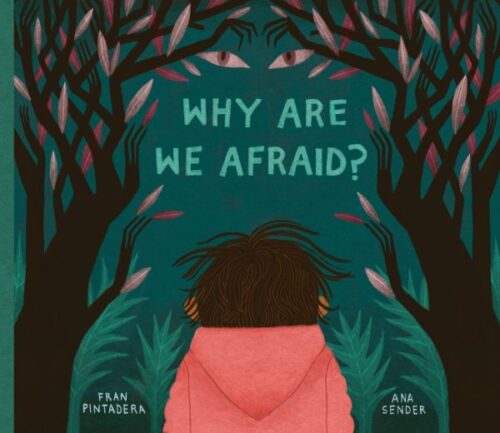
ADVERTISEMENT
ADVERTISEMENT
Fear gets a proper treatment in a rather lovely Spanish import. It’s interesting that often when I see Spanish nonfiction titles for children brought to the States I don’t see a lot of backmatter. Then here we have this nice little fictional picture book and voila! Backmatter galore about “the original fear”, “the types of fear”, “the lessons behind our fears”, “the masks of fear”, “the appeal of fear”, and finally some activities for talking through fears with kids. All this makes the book sound a bit like one of those purposeful books, but the title is quite an artistic endeavor more than anything else. Lovely, deep, and sumptuous art tells the story of Max who asks his father, “Dad, have you ever been afraid?” It’s an interestingly evocative story full of deep-seated fears brought to life. I think that a kid could get quite engulfed in a book of this sort. The message may stay with them, but it’s just as likely that the images will. My personal favorite is the two-page spread where Max is seen with wings staring up at flying people, a ball and chain attached to his leg while the text reads, “Often we’re afraid of freedom, strange as it seems.” A more artistic rendering of something all children, on some level, know very well.
The Wilderness by Steve McCarthy
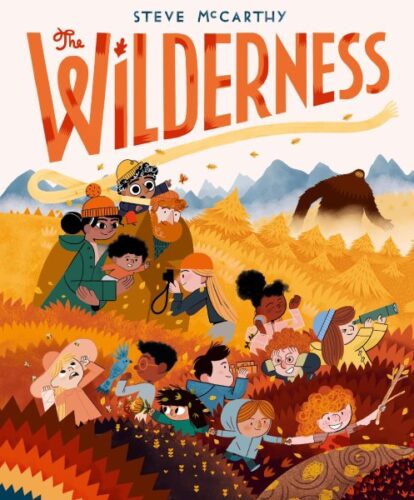
Young Oktober, one of twelve kids, is not a fan of the wilderness, but when circumstances beyond his control plunge him into the heart of nature, he finds that maybe things aren’t quite as scary as all that. As I am always in love with a cacophony of chaos, as well as stories about anxious kids, this hits the sweet spot. I sort of also adore big family stories. If the illustrator looks familiar here that might be because you’re familiar with the animated film Song of the Sea. I’m not a fan of overt messaging, but this does pretty good job showing how you can expand your boundaries a little. Plus the endpapers are the absolute best this year.
You Are a Story by Bob Raczka, ill. Kristen and Kevin Howdeshell
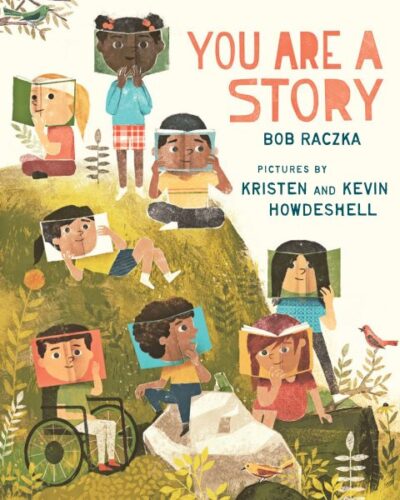
I will admit that when I read the title of this book I was, at first, hesitant to read it. In a given year one may encounter a LOT of you-are-special books as well as books-are-important books. I was a bit worried that this might be a combo of the two and it is . . . but in the best possible way. Trust Bob Raczka. The man’s been in the business a while and he’s not going to try to spoonfeed your children pablum. The book is helping kids to define what they are. “You are an animal” it says, and it explains that part (this was a question I myself had as a kid and this year it comes up in this book as well as the nonfiction picture book We Are Human Animals). It says “You are a body of water” because we are more than half made of water. “You are an astronaut” because you ride the Earth around the sun. I love how the science is just so delicately interwoven into the definitions. In the end “You are a story” and it closes with “Tell your story to others. Then listen to theirs.” Sound advice for literally every person.
You Go First by Ariel Bernstein, ill. Marc Rosenthal
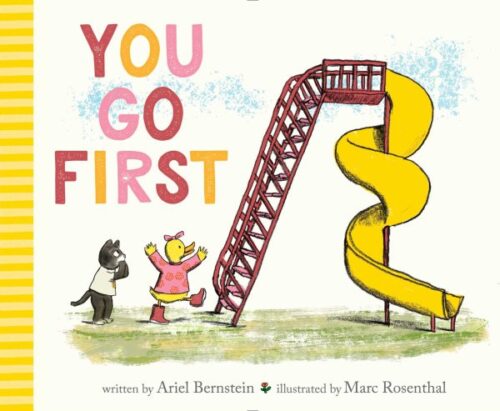
Alright, Ariel Bernstein. You got me. 2023 is turning out to be a particularly good year for anxious picture book protagonists. I’d pair this book with the aforementioned Wilderness by Steve McCarthy without hesitation. Of course, in this book the scary new thing is a twisty slide. Cat and Duck are very good friends but Cat is NOT so sure about this new slide that’s just appeared in their playground. Duck is all for trying it immediately if not sooner, so Cat uses every possible tool in his arsenal of arguments to dissuade his friend. What makes the book work so well is that you’re kind of getting this as a unreliable p.o.v. of Cat himself. A sentence like, “Cat, a very good friend, worried for Duck’s safety,” is not, as you might imagine, the whole story. What makes the book work so well is how Duck uses Cat’s better instincts to confront his fears himself. “Duck was a very good friend.” Nails the ending, and is just one of the best little unassuming books about a topic that a LOT of kids will relate to.
Hope you enjoyed these! Here are the lists you can expect for the rest of this month:
December 1 – Great Board Books
December 2 – Picture Book Readaloud
December 3 – Simple Picture Book Texts
December 4 – Transcendent Holiday Picture Books
December 5 – Rhyming Picture Books
December 6 – Funny Picture Books
December 7 – CaldeNotts
December 8 – Picture Book Reprints
December 9 – Math Books for Kids
December 10 – Gross Books
December 11 – Books with a Message
December 12 – Fabulous Photography
December 13 – Translated Picture Books
December 14 – Fairy Tales / Folktales / Religious Tales
December 15 – Wordless Picture Books
December 16 – Poetry Books
December 17 – Unconventional Children’s Books
December 18 – Easy Books & Early Chapter Books
December 19 – Older Funny Books
December 20 – Science Fiction Books
December 21 – Fantasy Books
December 22 – Comics & Graphic Novels
December 23 – Informational Fiction
December 24 – American History
December 25 – Science & Nature Books
December 26 – Unique Biographies
December 27 – Nonfiction Picture Books
December 28 – Nonfiction Books for Older Readers
December 29 – Audiobooks for Kids
December 30 – Middle Grade Novels
December 31 – Picture Books
Filed under: 31 Days 31 Lists, Best Books, Best Books of 2023
About Betsy Bird
Betsy Bird is currently the Collection Development Manager of the Evanston Public Library system and a former Materials Specialist for New York Public Library. She has served on Newbery, written for Horn Book, and has done other lovely little things that she'd love to tell you about but that she's sure you'd find more interesting to hear of in person. Her opinions are her own and do not reflect those of EPL, SLJ, or any of the other acronyms you might be able to name. Follow her on Twitter: @fuseeight.
ADVERTISEMENT
ADVERTISEMENT
SLJ Blog Network
One Star Review, Guess Who? (#211)
Kevin McCloskey on ‘Lefty’ | Review and Drawn Response
Notable NON-Newbery Winners: Waiting for Gold?
The Seven Bills That Will Safeguard the Future of School Librarianship
Take Five: Newbery Picks, Part Two
Gayle Forman Visits The Yarn!
ADVERTISEMENT



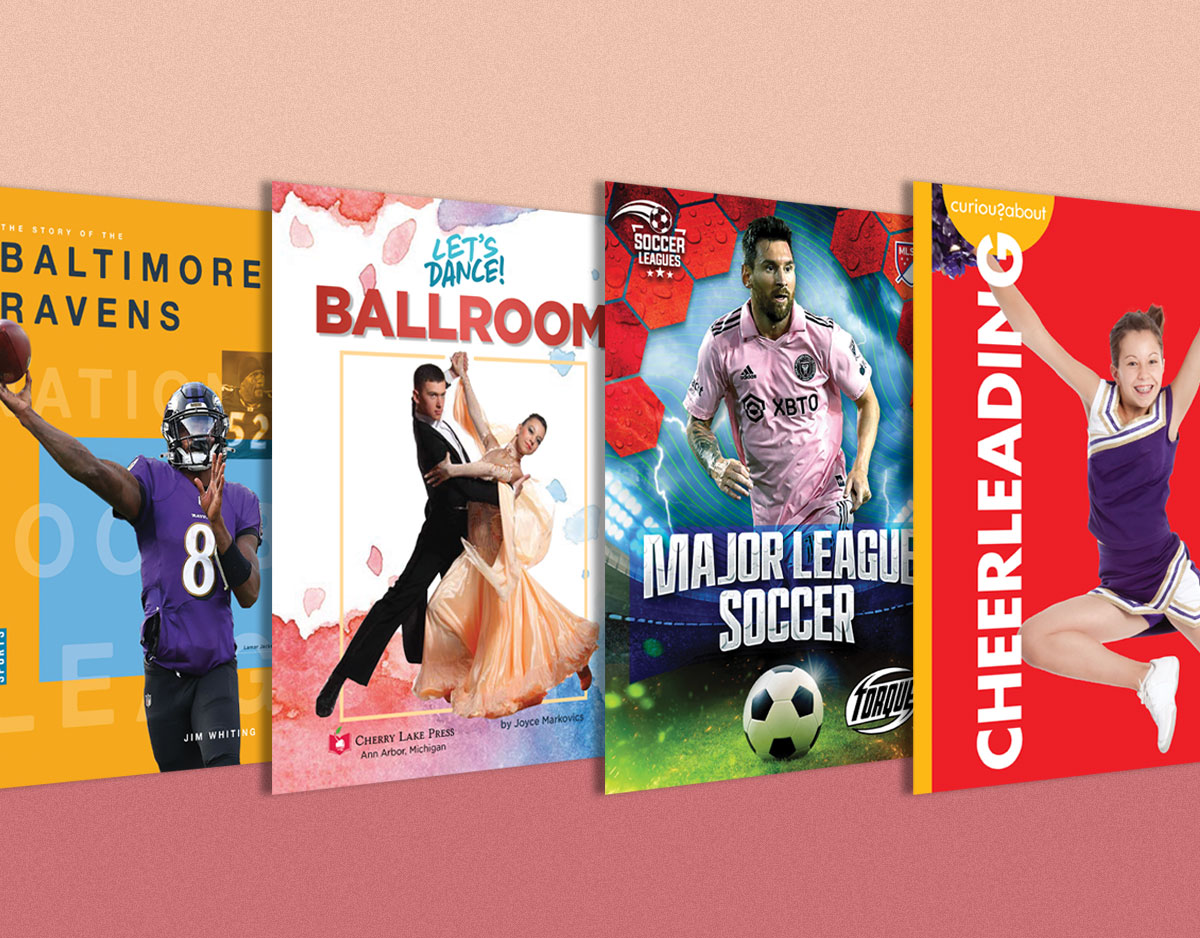
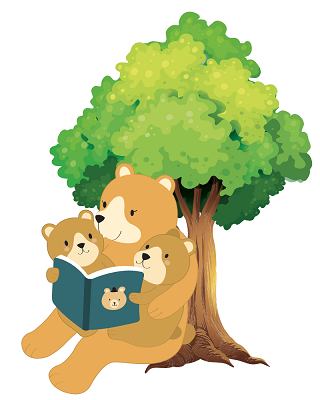
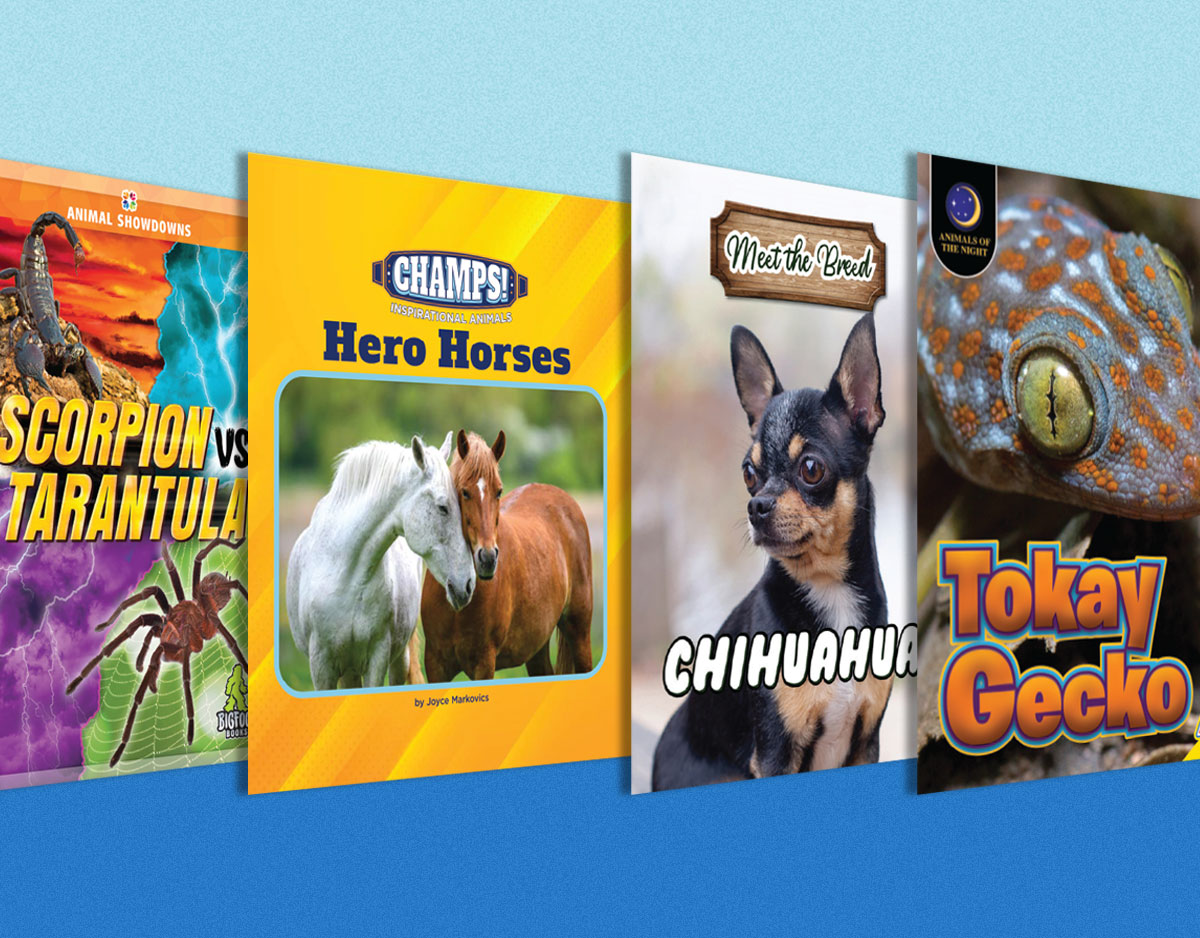
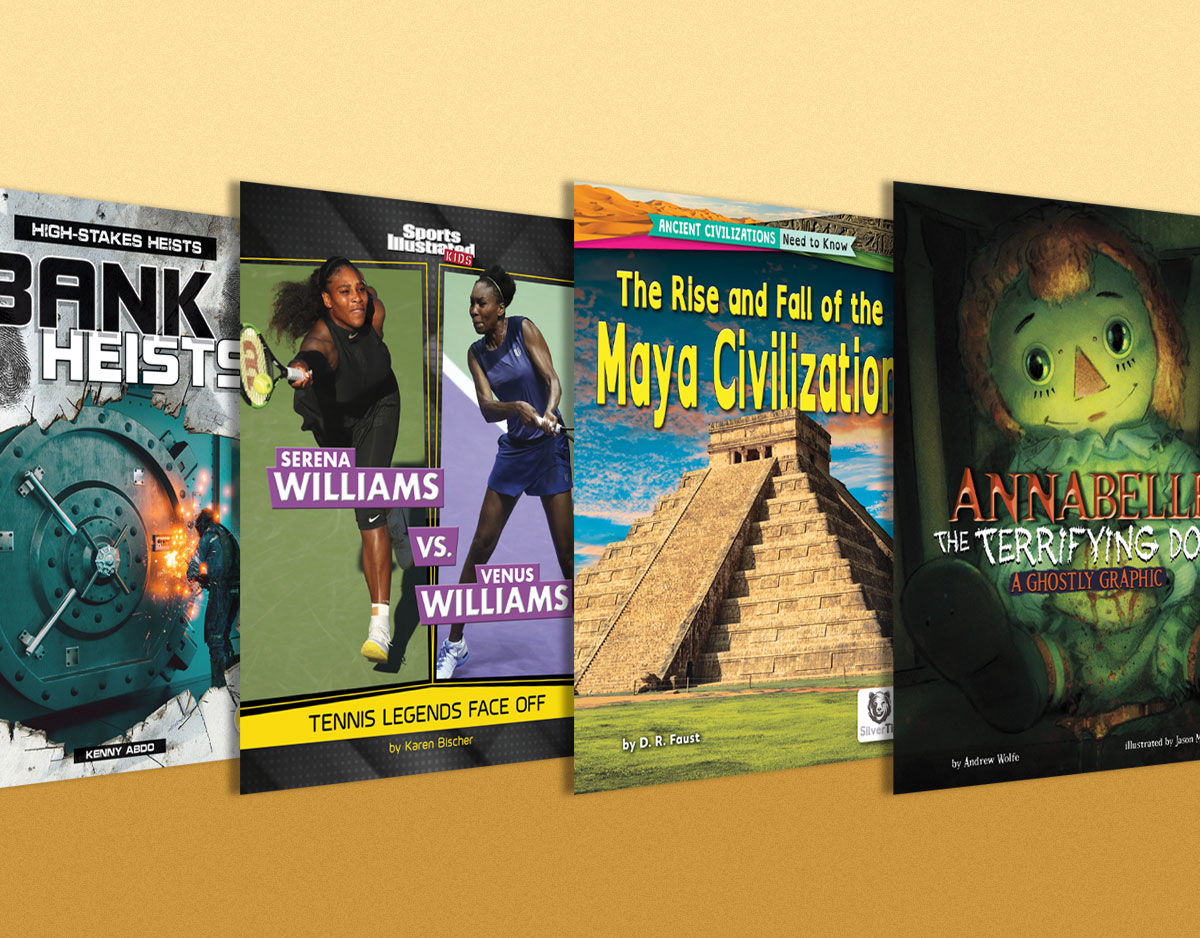
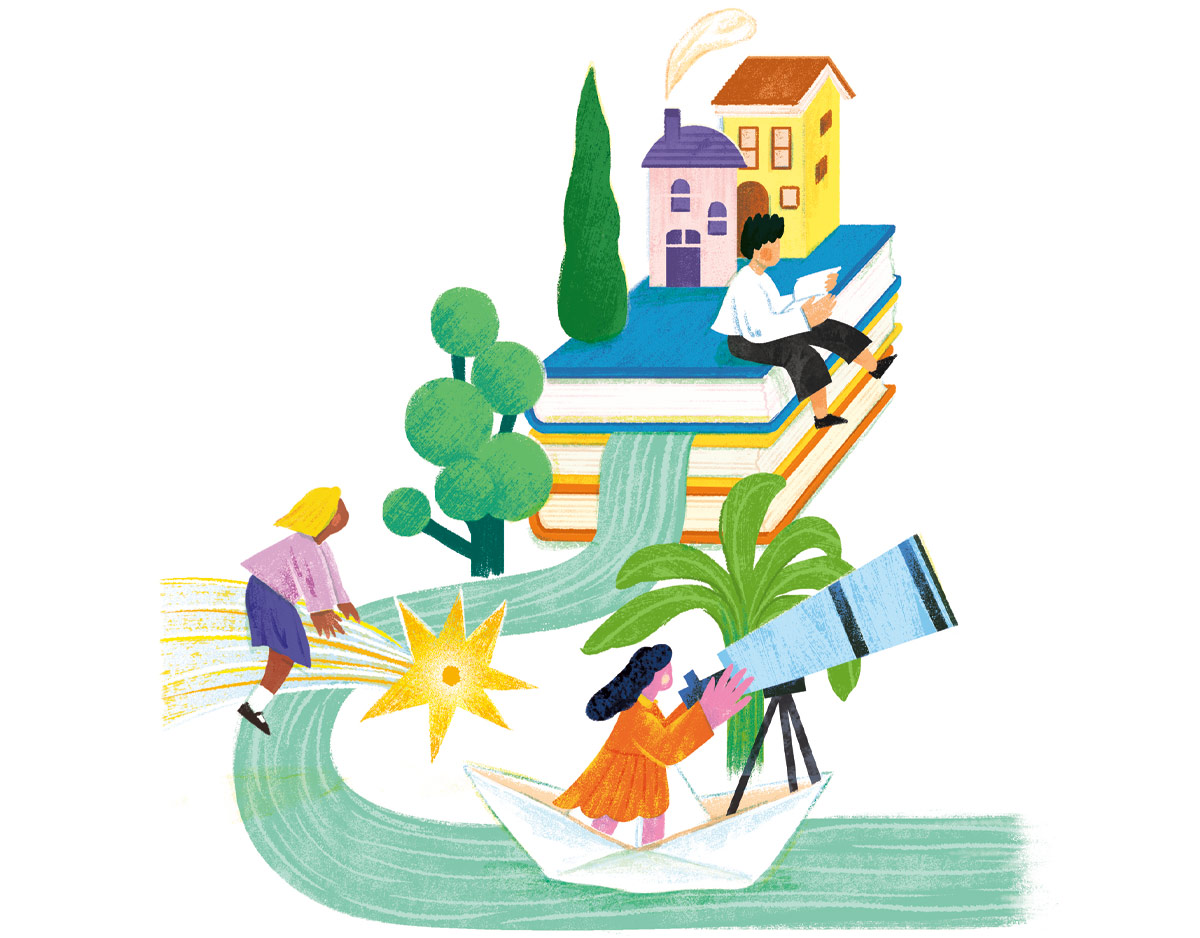
This is quite a diverse collection today. I read every word and still have questions about “message” books. I like this statement. “There is nothing wrong with a picture book with a message, as long as that message is beautifully written and illustrated.” You also mentioned the hundreds of books you encounter every year that fail to meet this criteria.
I think in some ways every book published has a “message”. An author has something to say and wants others to hear it. The better examples don’t cram those ideas down readers’ throats but try to provide context for readers to connect. I read to experience the unique world of others. I read to feel connected to shared experience and/or ideas. Both the familiar and the strange are important.
Grief is a topic of special interest to me. EMPTY AND ME and I WISH I COULD TELL YOU are two I am considering purchasing. I can certainly understand the value of BECAUSE I ALREADY LOVED YOU for those dealing with that special loss circumstance.
Another that stood out to me is CONNOR KISSED ME. I’d like to have that book shared with youngsters in all primary classrooms in our country.
Stumbled upon this post and love these lists! They’re perfect for grandma, who had lost touch with picture books as kids grew up and is now blessed with young granddaughters to read with! Thank you!
Big is hands down one of my favorite books of the year. I read it, bawled, and promptly bought it for my own collection (that I will share with my 2 year old daughter one day). This was a book that due to the illustrations, and the not overwhelming length, that I think kids will enjoy. Far too often “message” books are long and, frankly, written for adults and not kids.